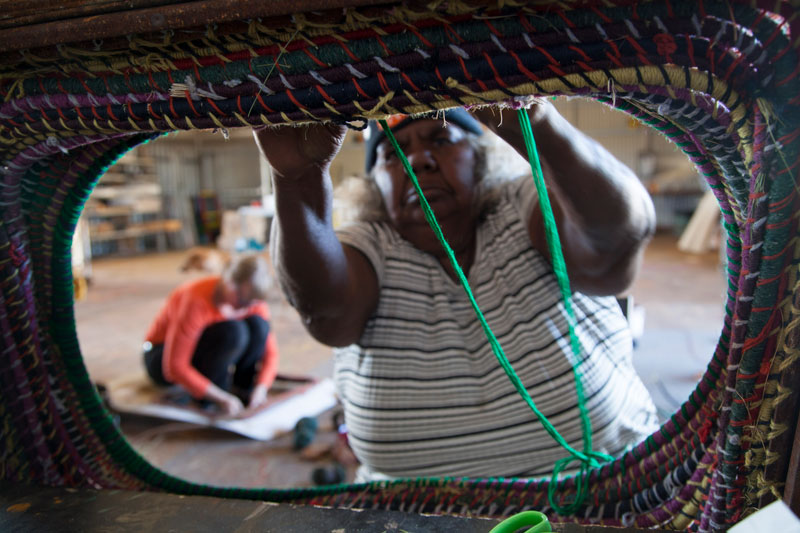
The Fremantle Art Centre, south of Perth is providing a much-needed focus in the field of cross-cultural exhibition making. Artist and curator Erin Coates has been at the centre of two exhibitions held at the FAC supporting the collaboration between Indigenous and non-Indigenous Australia. The first exhibition; We Don’t Need a Map: A Martu experience of the Western Desert in 2012 resulted in a range of artists collaborating with the Martumili Art Centre, which toured nationally. The projects were well-realised, complicated and contemporary. For this most recent curatorial project, In Cahoots, artists from six indigenous art centres initiated the invitations of seven independent artists largely based in urban centres to visit and collaborate. All but one of the participating art centres, Baluk Arts on Victoria’s Mornington Peninsula, are located in remote parts of Australia and take considerable planning and dedication to get to. Collaborators all met with each other a minimum of two times which in most instances established a residency period of about six weeks. The project developed over eighteen months and culminated in a sprawling exhibition of the resultant collaborations at the FAC galleries.
As an outcome of this exchange of ideas, community and location-centred thinking, In Cahoots wades into a transcultural landscape crossing local with foreign agendas, practices and techniques, which go some way to articulate a postcolonial experience. There is potential in these experiments to advance ideas of reconciliation and decolonisation through advocating a greater and more profound Indigenous presence, control and opportunity. This residency and exhibition project provides the potential for creative “epistemic disobedience”, which, as advocated by Ivan Muniz-Read, is needed to replace or complement “Eurocentric discourses and categories with alternative perspectives.”[1]
But self-determination is a relative thing. While the participating art centres were given the opportunity to choose an Australian artist to work with, the exhibition as an outcome notably focused on the invited guest artists, overshadowing the thirty-or-so community members they worked with. A similar dilemma is faced by socially engaged, community focused projects embedding an artist into a community, besieged by a certain social issue or collective disorder in order to make a cathartic collective artwork. A contract issued by the FAC to protect the authority of the individual artists to own the outcome failed to cement an even footing for all project collaborators. This left the realised projects themselves with the task of transcending the binary divisions, established through this show’s premise.
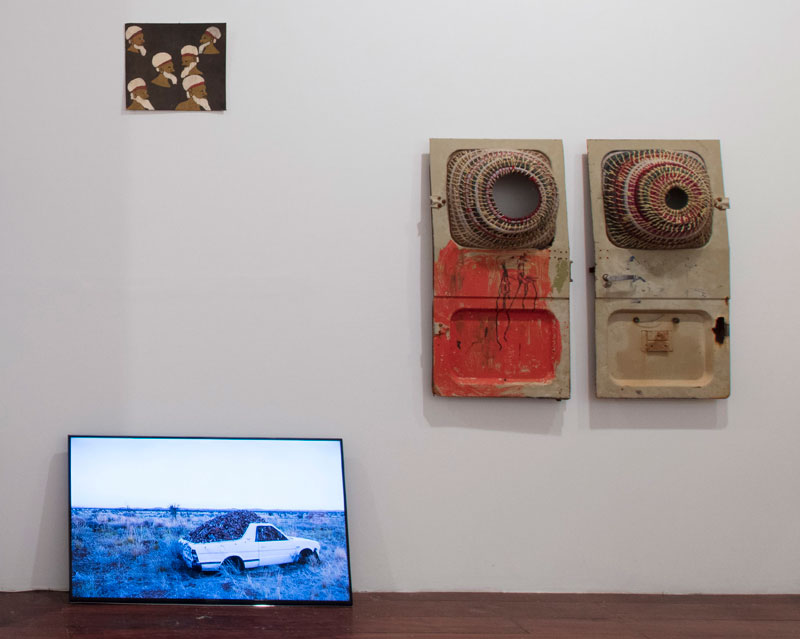
Among the participating guest artists, Claire Healy and Sean Cordeiro crafted a body of work with artists from the Parnngurr community, east of Newman in the Western Desert. The collective outcome is a visualisation of a process akin to “getting to know each other.” These powerful pieces combine found car body parts with intricate, colourful weavings and paintings that respond to the rusted steel surfaces. The weavings connect to the grand vistas of the Pilbara landscapes and were produced through a tradition, first introduced to Martu art communities in the early 2000s.
Sharing creative space with these works, Healy and Cordeiro produced a series of photographic pieces, based on site-responsive experiments. These speak to the cyclical nature of life through the metaphor of the car. The Pilbara craton, home of the Martumili Artists, is also the Australian base for the contemporary iron ore industry. Travelling through this vast landscape, one comes across cars rusting away on the side of the road, each of them with their own global manufacturing history tied to local ore extraction as well as personal dioramas. Healy and Cordeiro’s artistic interventions included adding words like “FALCON” and “BEETLE” to the sides of these wrecked, forgotten car bodies in large format text, connecting to postmodern, imperialist marketing traditions which assume the power of animal nature in a pitch to sell commodities. In addition, the room is populated with found objects and anonymously painted canvases drawn from the Parnngurr community area.
Sydney-based artist Tony Albert worked with Warakurna community members and artists to produce a collective work consisting of a vast quantity of naïve images created from reclaimed tin and steel. The resulting dispatches from daily Ngaanyatjarra life are hung salon style in an expansive conglomerate, expressing the vibrancy, ingenuity and craftsmanship which exists in this small remote town. Like Healy and Cordeiro, this structurally collaborative, sculpturally realised project was coupled with a work which bears great consistency with the visitors’ own practice, which in itself cannot be faulted. The missing aspect in these two key collaborations was an independent body of work produced by the immensely profound creative fraternity established at both the Warakurna and Martumili art centres – reflecting on the experiences from the residency. Without this, the two contributing sides do not share the same level of authority over the exhibition’s immersive resolutions.
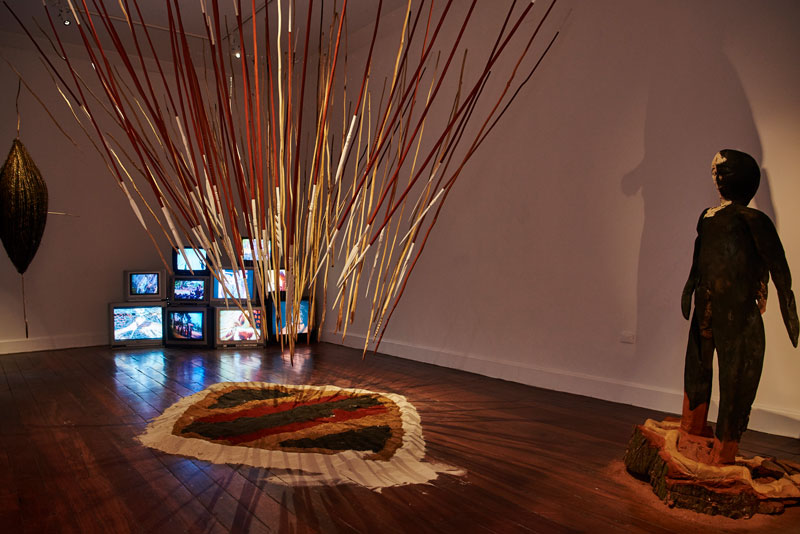
With the artists and art centres largely in charge, different collaborative groups decided upon different strategies to work together. At times this developed works on display that appear to exist through a cultural symbiosis. One such artefact, The Jangarra Armchair, was created in a partnership between Mangkaja Arts artists based in Fitzroy Crossing and Trent Jansen, an industrial designer based in New South Wales. This half couch, half art object borrows its form from Indigenous folklore, as well as its shape from the ubiquitous large red anthills found around the twenty-sixth parallel in Australia. The final object is both organic and refined. It is composed of traditionally carved wooden coolamons which then have had contemporary furniture applications placed upon them.
In this exhibition, works like The Jangarra Armchair draw from both of the differing cultures which produced them. But what fails to resound through this mixing of visual styles and applications were the individual stories of both sides of the collaboration. The trials and tribulations, the hardship as well as the complex social situations that the artists were placed into, as intimated in the essay statements in the catalogue and panel discussion, were too often erased by a constraining “artwork” as outcome. In these cases, the collaborators seemed to be trying to tie up the loose ends of complicated, ongoing dilemmas. Left out of this equation is the audience, who could have been implicated into the exhibition’s premise if cultural coexistence had been left unresolved and open for debate.
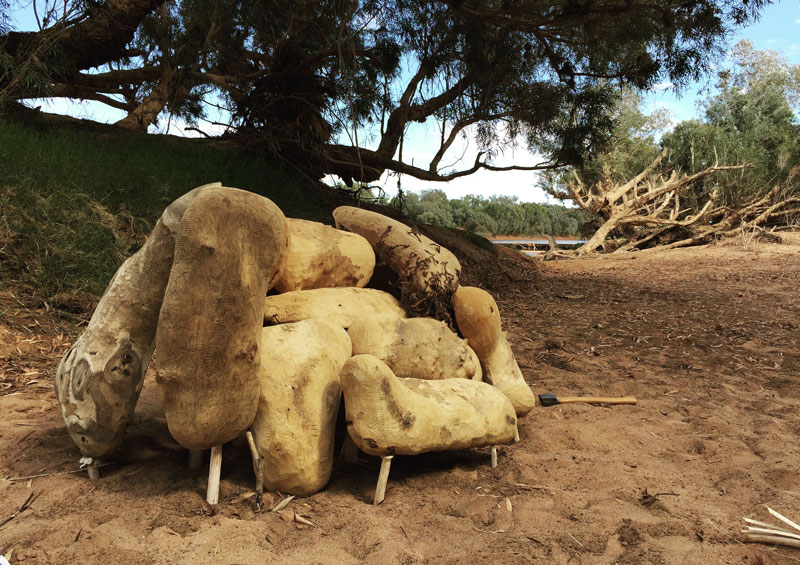
.jpg)
Perhaps unsurprisingly, the most heroic outcome of the In Cahoots experiment is a collaboration between two young Aboriginal men who come from different parts of the country: Ishmael Marika from the Buku-Larrnggay Mulka Arts Centre in the Northern Territory and Western Australia’s Curtis Taylor, a young filmmaker and artist of Martu heritage. The resulting work for In Cahoots is truly collaborative in spirit and provides an immensely rich explanation of difference, translation and personality. It contributes to a complex reading of the multiple systems that created it through imaging contemporary implications of ancient, ancestral Aboriginal lore. The power here, is the work’s ability to expose the transitioning fringes of Indigenous customs in contemporary Australian society.
One of the most striking cases of this is an artwork derived from a Martu cultural custom of weaving human hair traditionally used to make ceremonial hair belts. Taylor acted upon this tradition to create a sculptural form, which hangs in the air in front of a video examining the objects production. Ceremonial bloodletting is also used in this visually rich space as a form of wall painting. These artworks, amongst others in the room; act as a podium to disrupt Western representations of Aboriginal identity. This is a burden placed on Indigenous artists, poets and sportspeople, as explained by Stephen Muecke, to “display this essence, or this or that skill, as if culture were an endowment of a totality.”[2] Here, Taylor and Marika destabilise the transcultural border zone, lifting the work beyond the limitations of Aboriginality where the two artists can begin to speak authoritatively.
Apart from this unique collaboration between two individual Indigenous artists, the creative logic of In Cahoots remains limited by one-directional exchanges. As is too often the case, work by non-Western artists enters a Western system of creative logic in a process which is largely one directional. Furthermore, the exhibition fails to produce a cultural space that is critically reflective of the circumstances producing Australia’s art/ethnographic binary. As discussed by Laura Fisher, this dislocation is perhaps due to a “desire for recognition on the part of indigenous actors, and the desire for post-colonial redemption on the part of non-Indigenous actors.”[3]
Curatorial practice has great potential to undermine these categories or at least to form emancipatory bridges to support cross-cultural spaces where their necessity can be questioned. A helpful distraction to these binary logics is the rising voice of Aboriginal curatorial input into the Australian arts ecology. Curators working independently as well as in an institutional level such as Stephen Gilchrist, Brook Andrew, Tess Allas, Paola Balla, Hetti Perkins and Djon Mundine, to name a few, have shown us that there is great room for Indigenising the white cube. When this happens, difference becomes a ground on which to stand upon and can contribute to productive civic spaces, that at their best will address complicated and entangled postcolonial dilemmas.
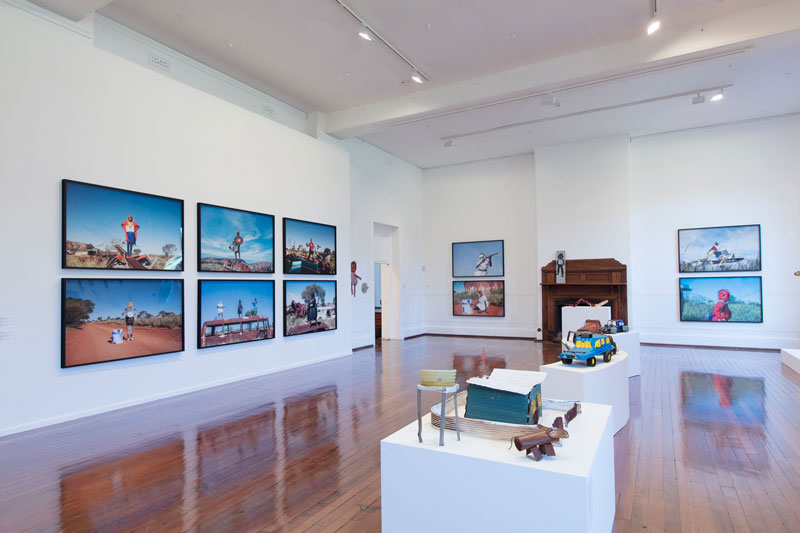
Footnotes
- ^ Ivan Muñiz-Reed, ‘Thoughts on curatorial practices in the decolonial turn’, Broadsheet, 45:2, 2016, p. 16.
- ^ Stephen Muecke, Textual spaces: Aboriginality and Cultural studies. Intl Specialized Book Service Inc., 1992.
- ^ Laura Fisher, The Art/Ethnography Binary: Post-Colonial Tensions within the Field of Australian Aboriginal Art. Cultural Sociology, 6:2, 2012, pp. 251–70.
